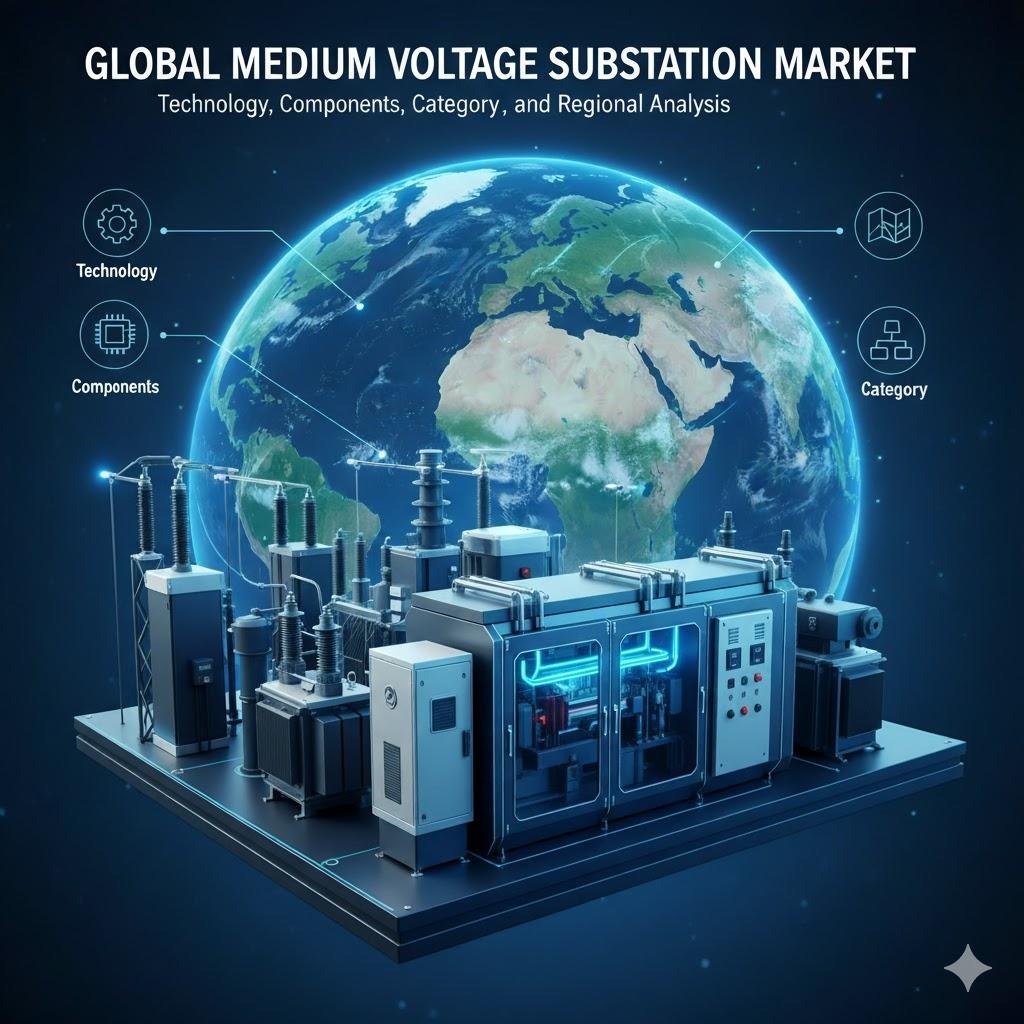-
Новости
- ИССЛЕДОВАТЬ
-
Статьи пользователей
Global Medium Voltage Substation Market: Technology, Components, Category, and Regional Analysis (2024–2032)

The global medium voltage (MV) substation market is poised for significant growth between 2024 and 2032, driven by the global imperative for energy transition, grid modernization, and rising electricity demand. MV substations (typically 1kV to 36kV) are critical nodes in the power distribution network, stepping down voltage from high-voltage transmission lines for industrial, commercial, and residential use. The market is evolving from traditional, passive grid connections to intelligent, digitally-enabled hubs that enhance grid reliability, efficiency, and resilience. Key growth drivers include investments in renewable energy integration, urbanization, industrialization in emerging economies, and the replacement of aging infrastructure in developed regions.
According to Credence Research the medium voltage substation market size was valued at USD 52 billion in 2024 and is anticipated to reach USD 76.9 billion by 2032, at a CAGR of 5.02 % during the forecast period (2024-2032).
Source: https://www.credenceresearch.com/report/medium-voltage-substation-market
1. Technology Analysis
The market is segmented by technology into two primary categories:
a) Conventional/Traditional Substations
- Description: These are long-established substation designs with primarily electro-mechanical and analog components. They have limited remote monitoring and control capabilities.
- Characteristics: Reliable and well-understood technology, but often require manual intervention for operation and maintenance. They are less flexible and adaptive to changing grid conditions.
- Market Position & Outlook: Still holds a significant market share, especially in regions with slower grid modernization or for simple distribution applications. However, growth is slower compared to digital substations, as the focus shifts towards automation.
b) Digital Substations
- Description: This is the high-growth segment, characterized by the use of digital communication protocols (most notably IEC 61850), intelligent electronic devices (IEDs), and process bus technology. They replace traditional copper wiring with fiber optics for communication between switchgear, transformers, and the control room.
- Key Enabling Technologies:
- IEC 61850 Standard: The cornerstone of digital substations, enabling interoperability between devices from different manufacturers.
- Intelligent Electronic Devices (IEDs): Digital relays, controllers, and meters that provide protection, control, and monitoring.
- Process Bus: Digitizes measurement and status signals at the source, transmitting them via Ethernet.
- Cybersecurity Solutions: A critical component, as increased connectivity elevates the risk of cyber-attacks.
- Market Position & Outlook: This is the future of the market. Driven by the need for:
- Enhanced Grid Reliability: Faster fault detection and isolation.
- Reduced Operational Costs (OPEX): Less maintenance, remote diagnostics, and smaller physical footprint.
- Improved Data Analytics: Collection of vast amounts of operational data for predictive maintenance and optimization.
- Easier Integration of Distributed Energy Resources (DERs): Such as solar and wind farms.
2. Components Analysis
The market is broken down by the key physical and digital components that constitute a substation.
a) Primary Components (Power Path)
- Switchgear: The most critical component, responsible for controlling, protecting, and isolating electrical equipment. Includes circuit breakers, disconnectors, and contactors. The trend is towards gas-insulated switchgear (GIS) for its compact size and reliability, especially in urban areas.
- Transformers: The core of the substation, used to step down voltage from the transmission level to the distribution level. Key trends include the adoption of amorphous core transformers for higher energy efficiency and the development of smart transformers with monitoring capabilities.
- Busbars: Conductors that serve as a common connection point for multiple incoming and outgoing circuits.
- Protection & Control Systems: This includes the "brains" of the substation.
- Relays (now IEDs): Protect the system from faults like overcurrent, earth faults, etc.
- Supervisory Control and Data Acquisition (SCADA): For remote monitoring and control.
- RTUs (Remote Terminal Units): Interface with field devices and communicate with the central SCADA system.
b) Secondary Components (Auxiliary Systems)
- Battery Backup Systems: Essential for providing uninterrupted power to protection and control systems during a main power failure.
- Communication Systems: Fiber optic networks, routers, and switches that enable data transfer within the digital substation and to the utility's control center.
- Cybersecurity Systems: Firewalls, intrusion detection systems, and encryption tools specifically designed for operational technology (OT) environments.
3. Category Analysis
This segmentation defines the physical construction and installation type of the substation.
a) Indoor Substations
- Description: Housed within a building or a dedicated enclosure.
- Advantages: Protected from weather, pollution, and salt corrosion, leading to longer equipment life and lower maintenance. More secure from physical tampering.
- Applications: Dense urban areas, industrial plants, commercial complexes, and regions with harsh environmental conditions.
b) Outdoor Substations
- Description: Equipment is installed in an open yard, exposed to the environment.
- Advantages: Lower initial construction cost, easier to expand, and better ventilation for heat dissipation.
- Applications: Rural areas, utility-owned distribution points, and locations where space is not a constraint.
c) Other Categories (Fast-Growing Segments)
- Prefabricated/Modular Substations: Built in a factory and shipped to the site as pre-assembled modules. They significantly reduce installation time and cost, improve quality control, and offer a compact footprint. Highly popular for temporary power, mining sites, and rapid grid expansion.
- Mobile Substations: Mounted on a trailer for high mobility. Used for emergency power restoration, providing temporary power during maintenance, or for special events.
4. Regional Analysis (2024–2032)
a) Asia-Pacific (APAC)
- Market Status: The largest and fastest-growing regional market.
- Growth Drivers:
- Rapid Urbanization & Industrialization: Especially in China, India, and Southeast Asia (Vietnam, Indonesia).
- Massive Investments in Grid Infrastructure: Government initiatives like India's "Power for All" and China's State Grid upgrades.
- Explosive Growth of Renewable Energy: Leading the world in new solar and wind capacity installations, each requiring MV substations for grid connection.
- Increasing Electricity Access: In developing parts of the region.
- Key Countries: China, India, Japan, South Korea, Australia.
b) North America
- Market Status: A mature market with strong growth driven by modernization.
- Growth Drivers:
- Aging Infrastructure Replacement: A significant portion of the grid is old and requires upgrade to digital, resilient systems.
- Integration of Renewables & DERs: Strong push for solar, wind, and energy storage, necessitating advanced substations.
- Grid Hardening: Investments to make the grid more resilient against extreme weather events and cyber threats.
- Industrial & Data Center Growth: New industrial facilities and massive data centers require reliable and robust MV substations.
- Key Countries: United States, Canada.
c) Europe
- Market Status: A technologically advanced market focused on energy transition and digitalization.
- Growth Drivers:
- Ambitious Green Deals & Decarbonization Goals: The European Green Deal is a major driver, requiring massive integration of offshore wind and other renewables.
- Grid Digitalization: Strong adoption of IEC 61850 and digital substation technologies.
- Cross-Border Interconnections: Projects to enhance energy security and share renewable power across countries.
- Phasing Out of Conventional Generation: Replacing fossil-fuel plants with decentralized renewables changes grid dynamics, requiring smarter substations.
- Key Countries: Germany, France, UK, Scandinavia, Italy.
d) Latin America, Middle East & Africa (LAMEA)
- Market Status: A mixed bag with high growth potential but varying levels of investment.
- Growth Drivers:
- Latin America: Investments in hydropower, solar, and wind energy, particularly in Brazil and Chile. Mining industry demands reliable power.
- Middle East: Economic diversification plans (e.g., Saudi Vision 2030) driving industrial and urban development. Shift towards renewable energy to free up oil and gas for export.
- Africa: Huge unmet demand for electricity, leading to new grid construction. Growth in mining and natural resource extraction.
- Challenge: Access to financing and political instability can hinder growth in some areas.
Market Outlook & Conclusion (2024–2032)
- CAGR: The global medium voltage substation market is expected to grow at a Compound Annual Growth Rate (CAGR) in the range of 5–7% during the forecast period.
- Key Trends:
1. Digitalization as Standard: Digital substations will become the default for new projects and major upgrades.
2. Focus on Cybersecurity: As substations become more connected, cybersecurity will be a non-negotiable feature.
3. Sustainability: Demand for SF6-free switchgear (using alternative gases like "green gas" mixtures) will rise due to environmental regulations.
4. Asset Performance Management: Using IoT and AI/ML for predictive maintenance to maximize asset life and prevent failures.
- Competitive Landscape: The market is highly competitive, featuring a mix of global giants (like ABB, Siemens, Schneider Electric, GE Grid Solutions, and Eaton) and regional players. Competition is based on technology, product portfolio, price, and the ability to offer integrated solutions and services.
In conclusion, the medium voltage substation market is transitioning from a static component of the grid to a dynamic, intelligent, and data-rich node essential for the future of a decentralized, digitalized, and decarbonized energy system.
Source: https://www.credenceresearch.com/report/medium-voltage-substation-market





